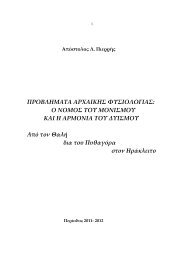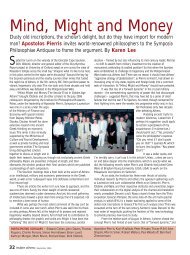Commentary on the Beginning of Damascius' De Primis Principiis
Commentary on the Beginning of Damascius' De Primis Principiis
Commentary on the Beginning of Damascius' De Primis Principiis
You also want an ePaper? Increase the reach of your titles
YUMPU automatically turns print PDFs into web optimized ePapers that Google loves.
37[33] It is essential that this should be added, as <strong>the</strong> causal relati<strong>on</strong>ship isc<strong>on</strong>stitutive <strong>of</strong> <strong>the</strong> essence <strong>of</strong> a cause as such, not a more or less accidental orextrinsic feature <strong>of</strong> it.[34] We sha ll see that we cannot determinately even say that anythingfollows from it.[35] I do not think that Chaignet ’s rendering “car, tout ce que nousc<strong>on</strong>cev<strong>on</strong>s, soit par intuiti<strong>on</strong>, soit par réflexi<strong>on</strong>, etc. » is particularly happy.[36] In <strong>the</strong> medieval scholastic sense <strong>of</strong> “intentio”.[37] These c<strong>on</strong>cepti<strong>on</strong>s (esp. <strong>the</strong> higher <strong>on</strong>es) are not <strong>the</strong> proper c<strong>on</strong>tent <strong>of</strong>our mind; ra<strong>the</strong>r we, operating at <strong>the</strong> limits <strong>of</strong> our faculties, get some intimati<strong>on</strong> <strong>of</strong><strong>the</strong> corresp<strong>on</strong>ding realities, and are thus able to form some sort <strong>of</strong> not i<strong>on</strong>sarticulating those intimati<strong>on</strong>s.[37a] 275.8 : οὐ μέντοι ἀλλὰ διακαθαίροντες αὐτὰς ( sc. τὰς ἐπιβολὰς ἤἐννοίας) καὶ συναιροῦντες εἰς τὸ δυνατόν etc. 276.9-12: τρίτην δὲ τούτοις ἐπάγομενδιακάθαρσιν ἐννοιῶν, οὐσίαν τε ἐκεῖ καὶ ζωὴν καὶ νοῦν θεωροῦντες οὐχ οὕτω μετὰδιακρίσεως ἐπὶ τῶν ὀνομάτων τούτων ἔχειν δοκεῖ. ἀλλὰ κατὰ τὴν μίαν τοῦ ἡνωμένουφύσιν, αὐτοῦ πρὸς ἑαυτὸ μόνον προβαλλομένου κατὰ τὴν δοκοῦσαν ὕφεσιν.[38] This is, <strong>of</strong> course, standard Neoplat<strong>on</strong>ic doctrine. It bears some ra<strong>the</strong>rexternal (c<strong>on</strong>tra Chaignet, p. 8 n. 2) similarity to <strong>the</strong> Stoic doctrine <strong>of</strong> τί as coveringboth being and n<strong>on</strong>-being, with <strong>the</strong> crucial difference however that Neoplat<strong>on</strong>ism farfrom identifying being with being a body, c<strong>on</strong>siders true being as ἀσώματον. On <strong>the</strong>o<strong>the</strong>r hand it is interesting to take notice <strong>of</strong> a certain Stoic development recorded byAlexander Aphrodisiensis , in Top icorum, 359, 12 Wallies (Fr. II 329 v. Arnim).There a divisi<strong>on</strong> seems to be entertained like thisἕν/ \(e.g. ἐννόημα) τι/ \ὄν (σῶμα) ἀσώματονIt would be perhaps interesting to pursue fur<strong>the</strong>r this subject, especially whenc<strong>on</strong>nected with certain testim<strong>on</strong>y usually left to pass unnoticed or unregarded, forinstance Fr. II 168 and Fr. I 65.










